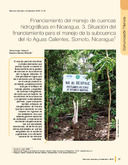| dc.contributor.author | López Nolasco, N. | |
| dc.contributor.author | Jiménez Otárola, F. | |
| dc.contributor.other | CATIE - Centro Agronómico Tropical de Investigación y Enseñanza | |
| dc.date.accessioned | 2015-03-19T21:35:41Z | |
| dc.date.available | 2015-03-19T21:35:41Z | |
| dc.date.issued | 2009-04 | |
| dc.identifier.issn | e-ISSN: 1659-1216 | es_EN |
| dc.identifier.uri | https://repositorio.catie.ac.cr/handle/11554/6323 | |
| dc.description | 8 páginas, 5 tablas, 11 referencias. | es_ES |
| dc.description.abstract | El estudio se realizó en la subcuenca del río Aguas Calientes y tuvo como objetivo analizar las experiencias de financiamiento de procesos con enfoque de cuenca para proponer un modelo adaptativo de financiamiento. La recopilación de información primaria se efectuó mediante entrevistas a actores a nivel comunal y municipal, e información secundaria. Los mecanismos de financiamiento más utilizados son aquellos promovidos por la cooperación internacional, que canaliza sus inversiones a través de ONG e instituciones nacionales y locales entre ellos destacan el fondo ambiental, donaciones, el presupuesto nacional, mecanismos comunitarios, líneas de crédito para canalizar recursos a acciones productivas y ambientales. Se observa un alto nivel de dependencia externa. El pago por servicios ambientales y la actividad turística podrían aprovechar inversiones del sector privado pero se visualizan a más largo plazo. Hay mecanismos de financiamiento indirecto, mediante los cuales las organizaciones y las familias contribuyen al manejo de cuencas, mediante el aporte de recursos como trabajo voluntario, medios y materiales. | es_ES |
| dc.description.abstract | The study was conducted in the Aguas Calientes River subwatershed to analyze the financing of watershed management actions in order to propose an adaptive of funding model. Primary information was gathered through interviews with municipal and communal stakeholders. The financing mechanisms most used were those promoted by international cooperation, which channels investments through NGOs and national and local organizations. Among the financing mechanisms are the environmental fund, donations, the national budget, community mechanisms and lines of credit for productive and environmental actions. A high level of external dependence is evident. In the long run, payments for environmental services and tourism could take advantage of investments from the private sector. There are indirect funding mechanisms, through which organizations and families contribute to watershed management with volunteer work or materials. | |
| dc.language.iso | es | es_ES |
| dc.publisher | CATIE, Turrialba (Costa Rica) | es_ES |
| dc.relation.ispartof | Recursos Naturales y Ambiente Número 56-57 (Abril-Agosto 2009), páginas 27-34 | |
| dc.rights | info:eu-repo/semantics/openAccess | es_ES |
| dc.subject | ORDENACIÓN DE CUENCAS | |
| dc.subject | FINANCIAMIENTO | |
| dc.subject | COOPERACIÓN INTERNACIONAL | |
| dc.subject | NICARAGUA | |
| dc.subject | PAGO | |
| dc.subject | SERVICIOS AMBIENTALES | |
| dc.subject | RECURSOS AMBIENTALES | |
| dc.subject | CUENCAS HIDROGRÁFICAS | es_ES |
| dc.subject.other | Sede Central | |
| dc.title | Financiamiento del manejo de cuencas hidrográficas en Nicaragua: 3. Situación del financiamiento para el manejo de la subcuenca del río Aguas Calientes, Somoto, Nicaragua | es_ES |
| dc.title.alternative | Financing watershed management in Nicaragua: 3. The situation in Aguas Calientes river watershed. | es_ES |
| dc.type | Artículo | es_ES |


